After studying the wines of
Germany and
Austria,
Derrick took us to
Hungary for our fifth session of the
Wines of Germany and Eastern Europe class.
Hungary may not be a well-known wine producing country, but with various soil types and climate conditions, it produces a wide variety of wines from an equally wide number of grapes. Although the country has no coastline, it is home to
Lake Balaton, Central Europe's biggest freshwater lake, and is divided in half by Europe's second-longest river, the
Danube. Hungary's climate is continental with long warm summers and extremely cold winters. Twenty two official Hungarian wine regions has been defined, with the most prestigious one being
Tokaj-Hegyalja.
Vineyards have flourished in Hungary since at least Roman Times. Many Italian and French grape varieties had been brought in and cultivated until the Turkish occupation between the 16th and 17th centuries. The
Kadarka grape, now Hungary's most widely cultivated variety, has been brought by the Serbs at the time when they were persecuted by the Turks. It is around the 16th century that the
Tokaj region became internationally famous for its late harvested Tokaji Aszú, also known as
the king of wines and the wine of kings. Sadly, wine production had been greatly neglected during the Communist years. However, the last ten years have seen a rapid awakening and modernization of the wine industry and fortunately for us wine lovers, Hungary is now trying to rediscover its own style of wine.

Vineyards near the Lake Balaton (from wineterroirs.com)The wines we tasted:
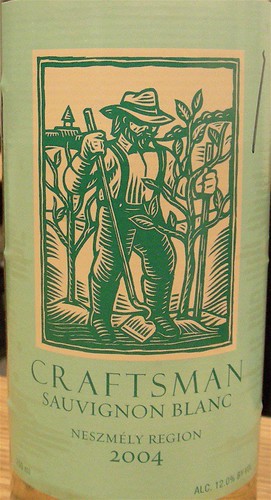
•
2004 Craftsman Sauvignon Blanc Neszmély: the wine is made by
Hilltop Neszmély, one of the largest producers and exporters of Hungarian wines. The wine comes from the
Aszár-Neszmély wine region, located northwest of Budapest, between the Danube and the Transdanubian mountain range. My notes: golden color, herbal nose with strong gooseberry aromas. On the palate, vivid acidity, dry, grassy with a dusty finish. An unusual Sauvignon Blanc.
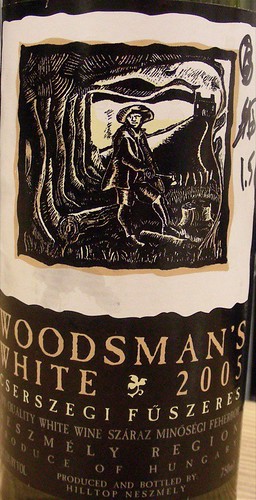
•
2005 Woodsman's White Cserszegi Füszeres Neszmély: this is another wine from
Hilltop Neszmély. The grape variety
Cserszegi Füszeres means
spicy grape from the town of Cserszeg and is a crossing of Gewürztraminer and the local white grape Irsai Olivér. My notes: light straw color, aromatic nose with floral aromas. On the palate, grapey with white blossom notes, fragrant.
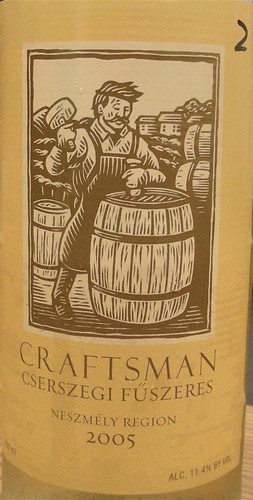
•
2005 Craftsman Cserszegi Füszeres Neszmély:also from the
Hilltop Neszmély winery and from the
Cserszegi Füszeres grape. My notes: golden color, fresh muscat-like nose, crisp with a good backbone and mineral notes on the palate, slightly more complex than the Woodsman's.
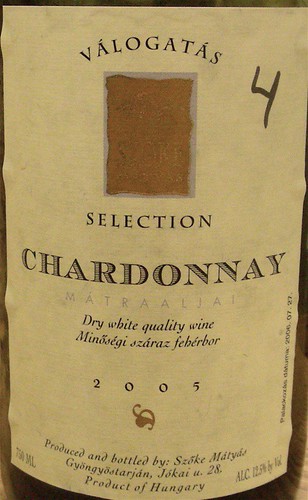
•
2005 Szõke Mátyás Valogatas Selection Chardonnay: the
Mátraalja wine district is located at the foot of the Mátra Mountains in Northern Hungary. It is one of the country's largest historic wine regions. Records as old as 1042 show that local peasants already cultivated vines in the area. The
Szõke Mátyás estate is the most important family owned winery of the Mátraalja region and exports half its production to Europe. My notes: light straw color, floral nose with citrus and green apple aromas, fresh acidity on the palate. Interesting Chablis-style Chardonnay.
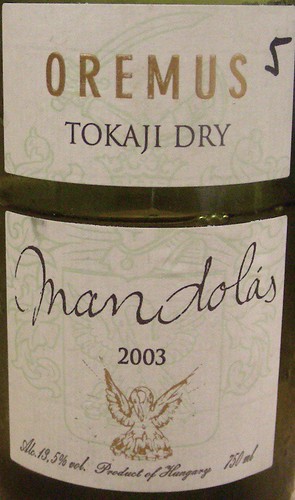
•
2003 Oremus Tokaji Dry Furmint Mandolás: The
Tokaj Oremus winery was created in 1993 by the Alvarez family, the owners of
Vega Sicilia in Spain. The wine is 100%
Furmint sourced from the estate Mandolás vineyard and vinified dry. My notes: dark golden color, spicy nose with pear aromas, peppery and mineral on the palate with a smoky finish. It is an opportunity to discover what Furmint tastes like just by itself.
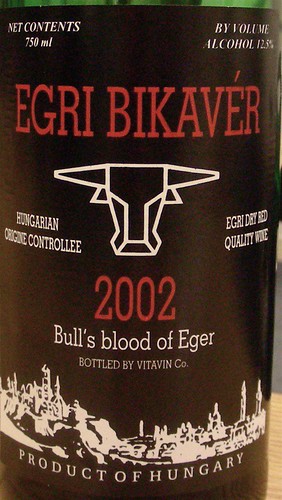
•
2002 Vitavin Egri Bikavér:
Egri Bikavér means
Bull's blood from the Eger region in Magyar and it is one of Hungary's best known wines. It has an interesting story that dates back to the 16th century. At the time, the Eger fortress was under attack by the Turkish troops. To give themselves courage and strength, the defenders drank the local wine in large amount, spilling it all over their body. When the attackers saw the defenders covered with red wine, they thought that the men had been drinking the blood of bulls and they fled in terror.
Eger is a medieval city in Northern Hungary famous for its historic buildings, its Minaret (northernmost minaret of Europe), and its wine cellars located in the nearby
Valley of Beautiful Women. Egri Bikavér is usually a blend of several varietals including
Kadarka, Kekfrankos (
Blaufränkisch), Médoc Noir (Merlot), and Cabernet Sauvignon. My notes: red/brown color, musky nose, rustic flavors on the palate, slightly oxidized. Not recommended.
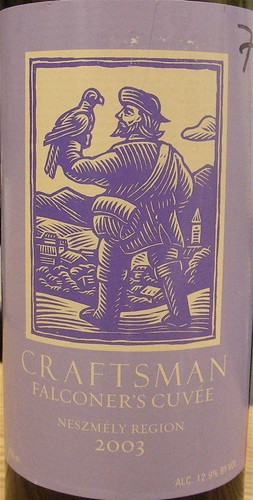
•
2003 Craftsman Falconer's Cuvee Neszmély: from the
Hilltop Neszmély winery, it is an unusual blend of Merlot, Cabernet Sauvignon, Pinot Noir, and Kekfrankos. My notes: brownish red color, Cabernet nose with notes of sweet blackberry. On the palate, tannic, oaky, with some good acidity, leaving some green flavors on the finish. Rustic but much better than the Egri Bikavér.
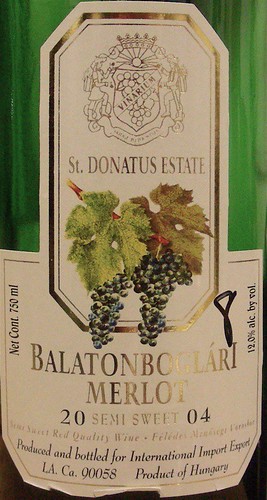
•
2004 St. Donatus Estate Balatonboglari Merlot Semi-Sweet: this wine comes from the Southern shore of
Lake Balaton, which is noticeably colder than the Northern shore where the deep waters have a temperate effect on the climate. My notes: medium red color, strawberry/raspberry on the nose, slightly sweet on the palate with a peppery finish. Not a bad wine but not easy to pair food with.
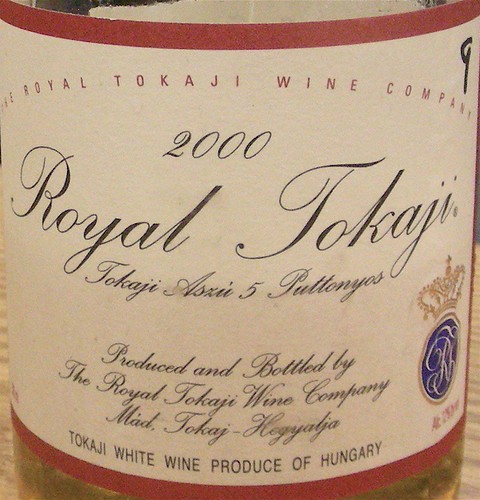
•
2000 Royal Tokaji Red Label Aszú 5 Puttonyos:
Tokaj-Hegyalja, Hungary's most famous wine region, is located 125 miles east of Budapest. The finest estates are on south/southeast-facing slopes overlooking the town of Tokaj. They enjoy a special microclimate characterized by hot summers and long, sunny autumns with morning fogs facilitating the development of
Noble Rot or
Aszú.
To produce Tokaji Aszú, Hungarians use unique vinification methods. The Aszú grapes (or botrytized grapes) are harvested by hand, one grape at a time, then crushed and combined with a dry wine. The proportion of Aszú grapes added to the base wine is measured in
puttonyos. One
puttony represents a 28-liter container that is poured into the traditional 136-liter cask of base wine. The number of puttonyos can vary from 3 to 6. My notes: the wine is a blend of
Furmint,
Hárslevelu (
meaning linden leaf), and Muscat. Dark golden color, apricot nectar on the nose with additional notes of tropical fruits. On the palate, luscious mouthfeel, vivid acidity with caramelized pineapple flavors on the finish. What a treat!
Coming next: the wines of Croatia, Slovenia, and Romania.
Related stories:
•
Wines of Germany and Eastern Europe class: Rheingau, Mosel-Saar-Ruwer, and Mittelrhein•
Wines of Germany and Eastern Europe class: Nahe, Rheinhessen, and Pfalz•
Wines of Germany and Eastern Europe class: Kremstal, Kamptal, and Wachau (Austria)Technorati tags: wine food & drink
 Unfortunately, I had a nasty cold this week and so I was not in the best condition to enjoy wine. However, I happily ate lots of oysters — only my favorites: Miyagis and Belons — on the half-shell, no sauce, accompanied with a bone dry Trimbach Riesling from Alsace.
Unfortunately, I had a nasty cold this week and so I was not in the best condition to enjoy wine. However, I happily ate lots of oysters — only my favorites: Miyagis and Belons — on the half-shell, no sauce, accompanied with a bone dry Trimbach Riesling from Alsace. 
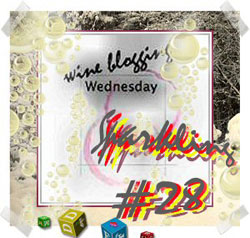
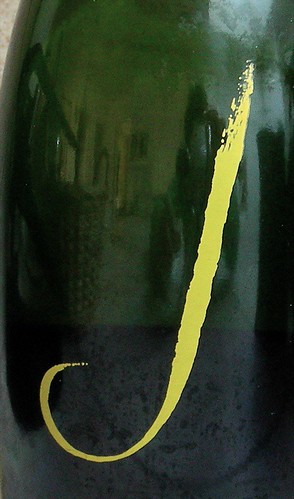
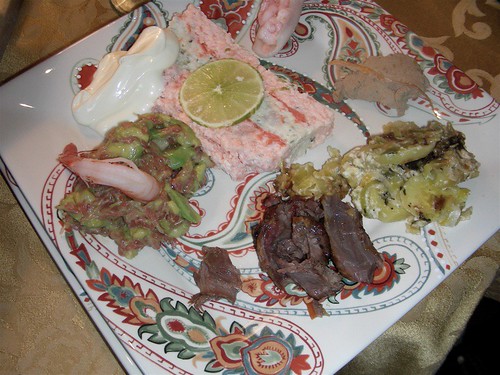
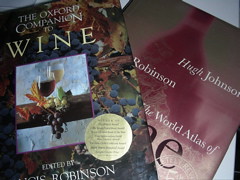 Now, if you are interested by everything that is related to wine, geography, history, winemaking, the whys and the hows, I have a special treat for you: my gift (use code WB16) is a copy of my two wine bibles:
Now, if you are interested by everything that is related to wine, geography, history, winemaking, the whys and the hows, I have a special treat for you: my gift (use code WB16) is a copy of my two wine bibles: 








